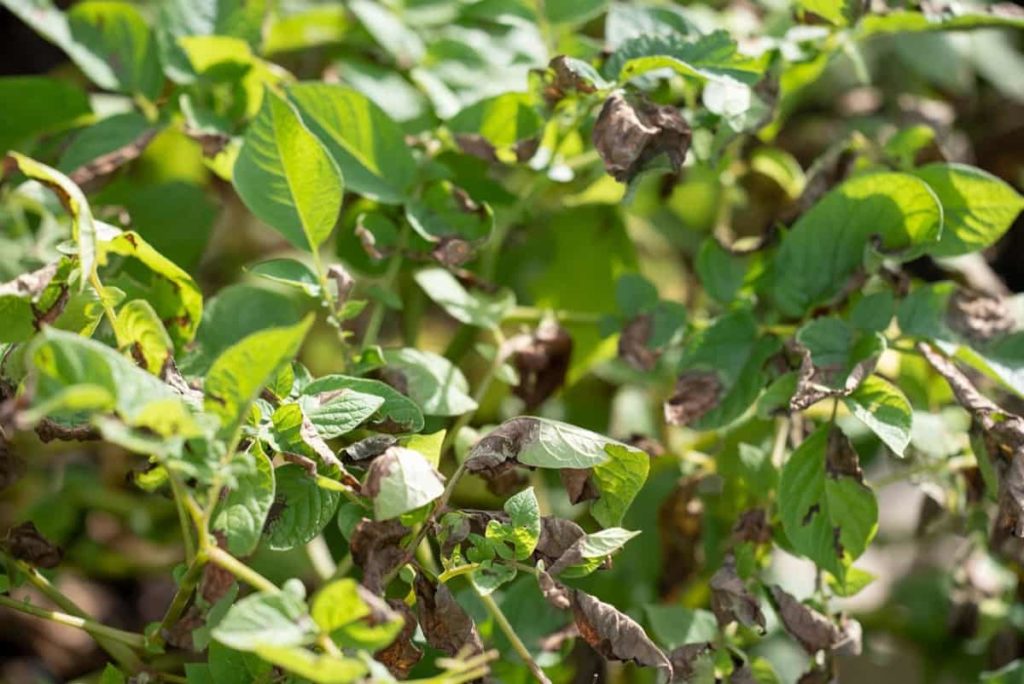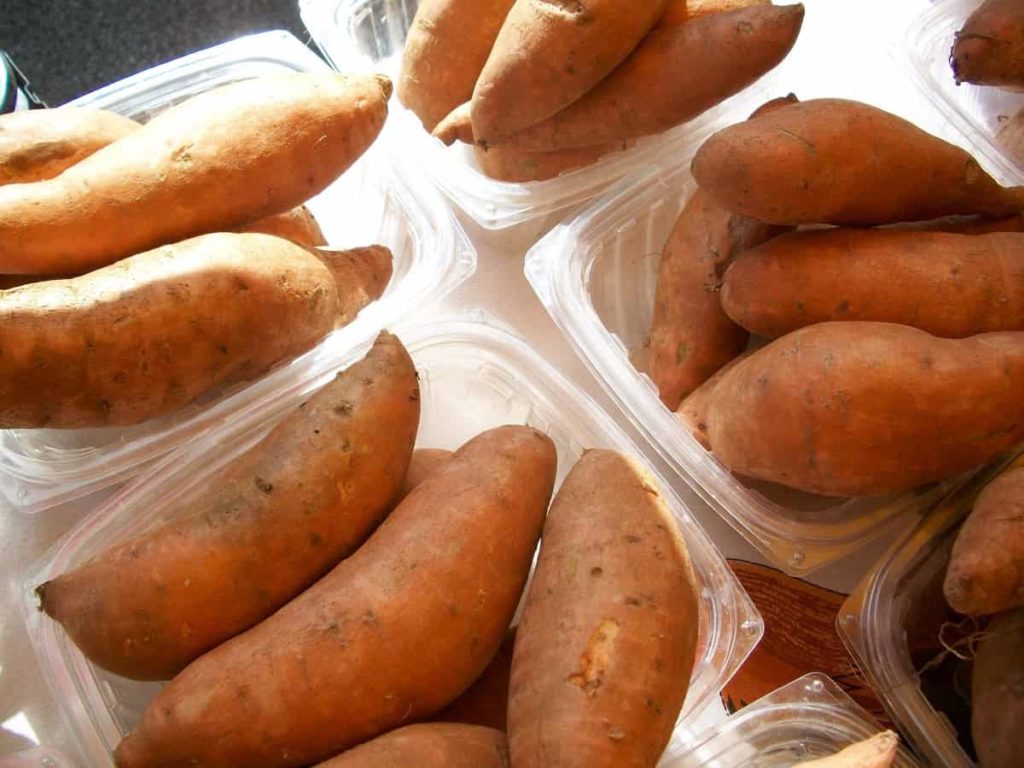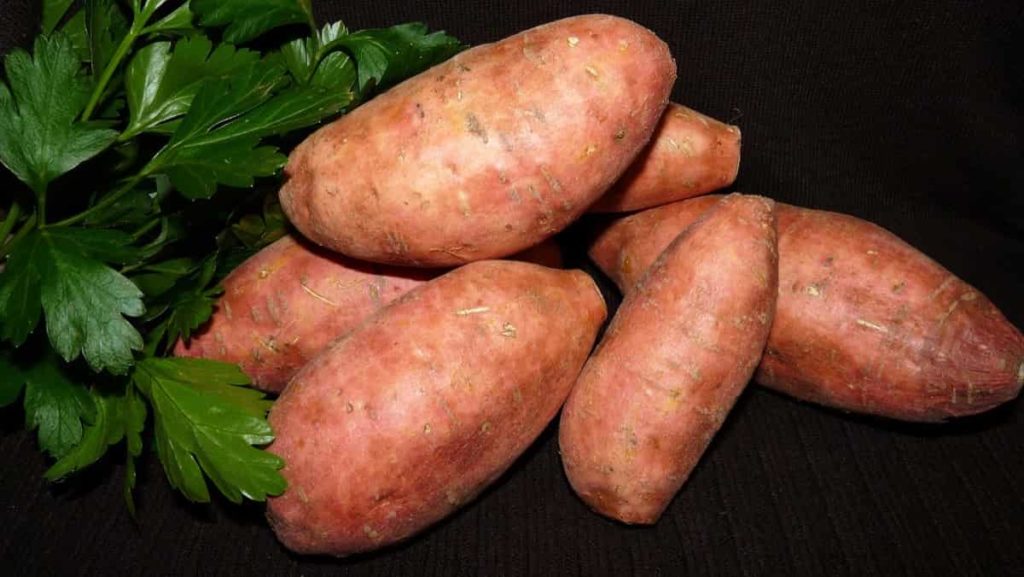Sweet potato originated in the tropical Americas and is also cultivated widely in the entire continent even before entering the markets of Asian countries. The introduction of sweet potatoes followed this to the needs of Europe & Africa. Scientifically named Ipomoea batatas, sweet potatoes are available in various colors like Orange, Red, Yellow, Copper, Purple, etc. Let’s check out more information on best practices to grow Sweet Potatoes at home.

In the Indian sub-continental region, most sweet potato is found in yellow or purple. While the taste is sweet and soothing, there are many benefits a sweet potato brings to the table like:
- Single sweet potato contains vitamin A four-fold times the average requirement of a human body per day. This could aid people with vitamin A shortage.
- Sweet potatoes also contain enzymes and nutrients that strengthen the immune system, keeping one resistant to diseases.
- The rich fiber content of sweet potatoes improves the health of the human gut and also improves the coagulation ability of blood.
- Sweet potatoes can wonderfully aid weight loss if consumed right but can provide equally negative results if not carefully consumed.
- It is also rich in Iron, Calcium, and other vital components that can improve overall health and increase virility.
Owing to the pandemic’s impact on the world, people have realized the need to eat clean and healthy. One of the first initiatives towards this is growing one’s food. On a large scale, people have started to produce all kinds of food they eat regularly. Given the benefits of sweet potatoes and their rate of consumption, people prefer the cultivation of sweet potatoes at home. Below are some common queries regarding the production of sweet potatoes at home.
Best practices to grow Sweet Potatoes at home
Can we grow sweet potatoes at home?
- Yes, sweet potatoes are feasible to be grown at home. They can be grown on both farms and in pots.
- The harvesting process is simple and has various methods by which it can be planted. For example, it can be produced as seeds, sprouts from the surface of other sweet potatoes, or pre-germinated seedlings.
- The catch in the process is the growth of the sweet potatoes is decided by the depth the roots of the plant are allowed to grow.
- This implies the pots must be tall and wide enough to accumulate the roots and the sweet potatoes that grow along with them.
In case you missed it: Common Poultry/Chicken Diseases, Symptoms, and Treatment: Check How this Guide Helps Poultry Farmers

What month do you plant sweet potatoes?
- Sweet potatoes grow best when planted at the end of winter and the onset of spring. Ideally, this period is selected due to the then prevailing temperatures.
- Sweet potatoes are warm-season plants that need adequate sunlight exposure and shade to yield the best.
- As sweet potatoes are perennial, they can also be planted in other seasons. Still, the care and efforts required for the cultivation in other than hot and humid conditions can be very complicated and tricky. Even then, one cannot expect a good yield compared to springtime.
Can you grow sweet potatoes in pots?
- Yes, sweet potatoes can be grown in pots. However, the pots must be in suitable dimensions for the plant to increase the roots deep enough to produce sweet potatoes.
- The selected pots must be extensive, have adequate height well above 1.5-2 feet, and be long enough to contain the roots. If not, the roots would either try to break the pot base, which is impossible in most cases, leading to the stoppage of root growth and inability to grow fully.
- The soil in the pots must be sandy loam soil with a slightly acidic to neutral pH value. It must be arranged so excess water is drained out quickly and no water retention occurs.
- If the excess water fails to drain and remains in the soil, the seeds or the plant can overdose on water and die, and the plant’s adhesive strength will be lost.
- The ideal pot size that would be big enough to grow a sweet potato plant is a 20-25 gallon container. An enormous container ensures the soil is appropriately and prevents soil rot.
How many sweet potatoes do you get from one plant?
- One can harvest 3-5 tubers from a single plant. That can weigh about 3-4 pounds. This count can differ in various seasons and times. For example, in summers, the average yield can be between 6-7 tubers; in winters, the count can come down to 2-3 tubers only.
- The productivity of the soil is an outcome of all the contributing factors like soil fertility, type of soil used, the quality of seeds used, watering frequency, etc.
- The crucial factor is using natural manure and compost only and not incorporating artificial fertilizers because fertilizers ultimately affect the growth of tubers only.
In case you missed it: Common Goat Diseases, Symptoms, and Treatment: Check How this Guide Helps Goat Farmers

How long does it take for sweet potatoes to grow?
- Sweet potato plants attain the stage of harvesting after 90-170 days. This is the stage where the sweet potatoes are sensitive to the weather conditions. Therefore, as a safety measure, the roots are taken out and harvested only after the cold weather settles.
- Before calling out for harvesting, one must ensure the maturity period is completed and that the crop has reached the harvesting stage.
- In cases of optimum conditioning, the growth time or maturity period is low as 90 days, wherein the vine continues to grow as a perennial.
Can you cut a sweet potato in half and plant it?
- Yes, sweet potatoes can be cut in half and planted. This is one of the three ways to produce a new plant from an existing one.
- The cut portion is placed in the soil, so the cut face is dipped into the ground, and the soil rich in nutrients is used to cover the piece well.
- This method is similar to planting a sprout formed on the surface of an already existing sweet potato, but the portion cut is significant in this case. The watering frequency and the manure provided remain the same as the methods.
How deep does the soil need to be for sweet potatoes?
- The soil has to be to a depth of at least 1.5-2 feet, preferably 18 inches and above. Without deep soil, the sweet potato plant roots cannot grow to the required depths to deliver sweet potato tubers.
- Adding to this soil depth, a few inches can be topped on the surface with purely natural manure or organic compost. This can stimulate plant seed or seedling growth, effectively delivering a harvest period less than in general cases.
In case you missed it: How to Grow Curry Leaf/Kadipatta Plant at Home: Check How this Guide Helps Beginners

Do sweet potato vines come back every year?
- Most often, sweet potato is grown as an annual crop because of the required weather conditions and seasonal changes.
- But in rare cases, like where the climatic conditions always remain hot and humid, sweet potato plants are grown as vines throughout the year as perennials.
- In some areas, artificially hot and humid conditions are created, and the growth is stimulated for increased productivity.
- Sweet potatoes are extensively cultivated in almost every country, making it 90% of the total tubers.
- A thick layer of mulch provided around the sweet potato pot can help maintain the soil’s originality without being affected by surrounding agents that can pollute the soil and help carry out cultivation throughout the year.
Do sweet potatoes need fertilizer?
- No. It is not advisable to supply fertilizers to sweet potato plants. This is because sweet potato plants yield the best when placed in natural soil enriched with raw manure and organic compost.
- Using fertilizers on a sweet potato plant would ruin its natural ability to yield rich and juicy tubers and may also lead to the growth of poisonous tubers fatal to consume.
How do you maximize a sweet potato yield?
- The yield of a sweet potato plant can be naturally increased by enriching the soil with Phosphorous, Sulphur, etc. but making sure to avoid Nitrogen direct usage.
- Make sure the soil is sandy loamy and can drain water. Water retention can be hazardous to both soil as well as the plant.
- At the same time, ensure the seed gets enough water to survive, along with adequate sunlight to perform photosynthesis.
- It is essential to wait for the right time to harvest because of the growth rate of tubers.
In case you missed it: How to Grow Microgreens from Seed to Harvest: Check How this Guide Helps Beginners

What can I not plant along with sweet potato?
- Certain plants do not grow well, along with sweet potatoes. However, almost all the plants grow well along with sweet potato, but only a few are not suggestible as they might stop each other’s growth.
- The plants of tomato, sunflower, and Squash can not be grown alongside sweet potato due to the vulnerability of potatoes to be infected by the produces of either of the three plants.
- Other than these three plants, sweet potatoes grow well with all different domestic crop varieties.
What is the step wise procedure to grow sweet potatoes at home?
- Sweet potatoes are grown on both farms and in pots. The usual practice is growing on farms where open land is filled with the required soil type and proper manure.
- Select a proper location such that the plant can be exposed to enough sunlight but at the same time get enough shade and time away from the sunlight.
- The soil for growing sweet potatoes is sandy loam soil with excellent water retention capability. Care is to be taken not to add any artificial fertilizers so that the earth’s biological productivity is not disturbed.
- As a next step, the quality seeds are selected from a trusted seed vendor or scraped from the surfaces of already grown sweet potatoes. For beginners, it is advisable to grow from already grown seedlings, as growing seedlings from seeds is a bit complicated.
- The seedlings are then placed in the soil at a depth of at least 3-5 inches with a row spacing of 30-40 inches gap between successive rows. The gap between each seed in a row is 10-12 inches.
- Soil manure has to be wholly natural, and nitrogen is to be avoided at any cost. Therefore, the waste is mainly obtained from natural compost.
- Regular watering of at least 2 inches from the soil is to be provided twice to thrice a week. This ensures the growth is not hindered due to water unavailability.
- After 90-120 days, depending upon the climatic conditions and temperatures, the sweet potatoes grow deep into the soil to a depth of 1.5 to 2 feet. This can be varied from one geographic location to another.
- If the conditions can be maintained intact, sweet potato vines can be cultivated perennially.
In case you missed it: Best Practices to Grow Green Chilli (Mirchi): The Best Guide for Beginners

Conclusion
- Though there are many varieties inn sweet potatoes, every array has the same contents and provides the same health benefits.
- Sweet potatoes are rich in nutrients, vitamins, and fibrous content necessary to keep human vitals in check and healthy.
- Even then, excess consumption of sweet potatoes is highly dangerous, as one can overdose on any element, which can sometimes be fatal.
- The demand for sweet potatoes is higher in European and African countries than in the Indian region.
- These were common queries regarding best practices to grow sweet potatoes at home.
- How to Raise Pigs in Your Own Backyard: A Comprehensive Guide
- Budget Friendly Sheep Shed Ideas: Cheap and Low-Cost Tips
- How Much Do Cattle Farmers Make: Revenue Streams in Cattle Farming
- Management Pests and Diseases in Your Cotton Field
- Sheep Farming Business Plan for Beginners
- Aquaponic Farming at Home: A Step-By-Step Guide
- Profitable Village Farming Business Ideas in 2024
- High-Yield Aquaculture: Fast-Growing Fish for Farming
- Effective Fish Pond Construction Techniques for Beginners
- Irrigation and Water Management in Pineapple Farming
- Blossom to Harvest: Mastering Flowering and Pollination in Papaya Farming
- Pig Fattening Essentials: From Selection to Sale for Beginners
- Raising Wagyu Cattle: A Complete Guide for Premium Beef Production
- Soil Types and Their Water Holding Capacity
- Optimizing Irrigation Schedules for Coconut Groves for Enhanced Yield
- Espresso Your Garden: Coffee Grounds for Healthier Acid-Loving Plants
- The Best Soil Mix for Snake Plants: How to Mix Your Own Snake Plant Soil
- Green Thumb Success: Expert Tips for Cultivating Greenhouse Beans All Year Round
- Bloom All Year Round: The Ultimate Guide to Indoor Hyacinth Care
- Eco-Friendly Gardening: How to Make Liquid Fertilizer from Kitchen Waste
- Ultimate Guide to Grow Anise in Pots: Explore Seed Propagation to Harvesting
- Guide to Raising Chester White Pigs: Discover Breed Facts to Growth Management
- Mastering the Elegance: The Ultimate Guide to Weeping Cherry Tree Care, Planting, and Maintenance
- Ultimate Guide to Planting Garlic in Grow Bags: Growing Strategies for Beginners
- How to Fix Spider Plant Leaf-Related Problems: Natural and Organic Remedies
- 10 Reasons Why Your Tulsi Plant is Shedding Leaves: Home Remedies and Solutions
- Optimizing Growth and Yield: The Advantages of Palm Bunch Ash Fertilizer
- Utilizing Neem Oil Extract as a Natural Pesticide for Hydrangea
- From Soil to Harvest: Various Ways in Which Farmers Can Use AI Tools
- Steps to Encourage and Induce Citrus Flowers: A Comprehensive Guide
- How to Fix Snake Plant Leaf-Related Issues: Natural and Organic Remedies
- Transform Your Garden into a Fragrant Oasis with Raat Ki Rani (Night Blooming Jasmine)
- Discover the Ideal Chicken Breeds for Philippine Farms
- How to Create a Poultry Egg Farm Business Plan for Profits
- Grow Lemon Cucumbers Like a Pro: Insider Techniques for Bountiful Yields
- Ultimate Guide to Caring for Your Pink Princess Philodendron: Tips for Thriving Variegation
